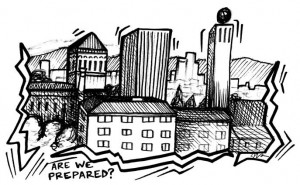Students must be ready for earthquake
Earthquake preparedness is an integral part of Japanese culture. Earthquake procedure pamphlets are a staple at elementary schools. Every year on Sept. 1, the country’s Disaster Prevention Day, many public and private facilities dutifully perform earthquake and fire drills.
Japan also spent hundreds of millions of dollars and more than a decade constructing an earthquake early warning system, which, when a 9.0-magnitude earthquake hit March 11, sent out millions of warning messages via cellphone, email, television networks, radio stations, schools and factories.
Japan is in the midst of dealing with the aftermath of a tragic, domino-like sequence of events — an earthquake followed by a tsunami that damaged a nuclear power plant — that it was, in fact, extremely well prepared for.
The disaster in Japan could have been even worse had the Japanese lacked their well -established system and culture of safety.
As students who live in an area long overdue for a major earthquake, we are in the perfect position — not only as a part of a well-connected campus environment, but also as part of a university with an award-winning emergency response plan.
Moreover, we have a multitude of earthquake preparedness resources.
Clearly, we can further our own culture of safety and preparedness in California.
Steve Goldfarb, fire safety and emergency planning specialist with USC Career and Protective Services, said in an email there is a 99 percent probability of a large (magnitude 6.7 or greater) earthquake occurring in California within the next 20 to 30 years.
Goldfarb argued, therefore, the annual ShakeOut drill demands participation from all students.
Researchers have found that major earthquakes occur, on average, every 88 years in the southern section of the San Andreas Fault, located near the San Bernardino mountains. The last massive earthquake (magnitude 7.9) was in 1857.
USC is well equipped to handle a future earthquake. When an earthquake hits, response begins with the Dept. of Public Safety activating the university’s response and recovery plan, according to Goldfarb. Officers then patrol campus to look for damage or injuries. The Emergency Operations Center, which is in charge of coordinating emergency response and recovery, handles any problems that might follow.
Similar to Japan’s emergency communication system, but on a much smaller scale, USC uses TrojansAlert, an instant notification system, to send a message to your email or cell phone in the case of an emergency.
“USC has an excellent emergency preparedness program,” Goldfarb wrote. “The more people are made aware of what to do and how to prepare and the more people actually take the time to get themselves prepared, the better off we will be.”
Still, it’s one thing to have an emergency response and recovery system with trained officials in place.
It’s another thing for students and faculty to be aware of proper earthquake procedure — in other words, for the Trojan community to engage in creating a culture of preparedness.
Disaster education is integral to learning how to prepare for the unthinkable.
Students can get educated and stay informed by taking advantage of the multitude of resources on campus, such as an earthquake preparedness workshop taught by Goldfarb scheduled for April 12.
Emergency preparedness is more than the ubiquitous fire phrase, “stop, drop and roll,” many of us probably memorized in elementary school.
“Stop, drop and roll,” isn’t even accurate in the case of an earthquake — it’s actually “Drop, cover and hold on.”
Such details might seem inane, but an ingrained knowledge of preparedness basics coupled with Japan’s earthquake early-warning system saved thousands of lives March 11.
It’s highly likely an earthquake will hit California in our lifetime. And it will happen sooner rather than later.
Students are the ideal jumping off point for increasing safety awareness and boosting California preparedness culture before that earthquake hits.
Elena Kadvany is a junior majoring in Spanish.
For more on the devastation in Japan, click here.

